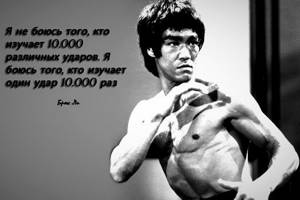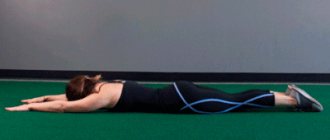In order to get the maximum effect from your training, you need to change your training program from time to time. Any professional athlete or sports doctor will tell you this.
Changing your training program is a necessary measure that allows you to prevent or overcome a training plateau, achieve better results and maximum muscle growth. Timely change of the physical activity program also helps to fight weight gain and get greater effect from the weight correction course.
Now let's figure out why we need to change the program, in what cases such changes are necessary, and how to organize them correctly?..
Why do you need to change your training program?
Our muscles are special fibers that quickly adapt to certain loads and stressful situations. Therefore, in order for them to grow, it is necessary to increase the load in time, change the muscle group being trained and adapt to the “windows” of maximum muscle performance.
Regularly changing your training program will allow you to effectively pump up your muscles, prevent the appearance of a training and weight plateau, develop strength and general physical endurance, achieve the desired results in weight correction and use your training time productively.
By regularly changing your strength training program, you will be able to maximize your working weight on machines and in deadlifts. You will feel an increase in endurance and strength, and subcutaneous fat tissue will return to normal.
If you do not change your training program in time, your muscles will adapt to the usual loads and exercises and will stop responding to them. As a result, the growth of muscle mass will stop, and the results will be fixed at a certain point without changing for the better.
Long-term adherence to the same program is acceptable only if you have achieved the desired results in weight, fat and muscle mass, developed endurance and strength to the required level and simply want to maintain yourself in this shape.
If you continue to strive for progress and new achievements, then changing your training program will be a necessity, not entertainment.
Should I increase the load or change the entire program at once?
Situations often arise when the choice is to change the entire program or simply increase the load. If such a situation arises, you must do the following:
- If your level of physical fitness allows you to increase the load, then doing so is enough to start with. It is necessary to increase the load when, after training, a slight burning sensation and pain are not felt in the muscles. Because this means that the load is not enough and the muscles were not well worked. The main thing is not to overdo it when increasing the load, as otherwise too much load will lead to injuries, some of which may last a lifetime. Also, the technique of performing the exercise suffers from the unbearable load, but it is the guarantor of the result.
- If the technique suffers from an increase in load, or the athlete cannot perform a sufficient number of repetitions, then it is better to immediately change most of the exercises from the program or the entire program. Even if a person thinks that this is the ideal program for him, he still needs to change it. If you continue to increase the load, it can ultimately lead to injuries and sprains. And if everything is left unchanged, then soon there will be almost no effect from the training.
It is not necessary to follow exactly this plan; if you are tired of the training program, you can simply change it immediately. Those athletes who are very accustomed to their program will be able to continue practicing it for some time with the help of increasing weight.
How often should you change your training program?
It is already known that the body needs about 3 weeks (21 days) to develop any habit. This rule works almost the same way with muscles.
How often you change your training program depends on several factors:
– on the person’s preparedness and his initial physical form;
– on the regularity and duration of training according to the primary program;
– on the results of training;
– on the individual characteristics of the body, including the adaptive capabilities of human muscle tissue.
Sports medicine specialists assure that muscles experience maximum stress from a new training program in the first 2-4 weeks of training. During this same period, the most active changes in muscle tissue occur.
From 5 to 8 weeks of training according to the program, a gradual decline in muscle activity begins, and the progress of muscle growth and athletic performance gradually slows down. During this period, muscles no longer grow as actively.
From weeks 9 to 20 of training, muscle fibers stop reacting under stress to the usual training program and load. During this period, a training plateau is possible.
You can understand that the muscles have adapted to the previous training program by your own feelings. If in the first 2-3 weeks of training you make an effort to perform the exercises, you feel tired and mild muscle pain (soreness after training), then over time the fatigue and pain disappear, the exercises are easy and without much effort.
The adaptation period continues differently for everyone:
– beginners in sports need 10-16 weeks (2.5-4.5 months) to master one training program and obtain maximum results;
– experienced athletes will have to change their training program after 8-11 weeks (2-3 months) of regular training;
– professional athletes and fitness trainers master a new program in 4-6 weeks (1-1.5 months).
Protein synthesis process
In the initial stages of intense stress, the nervous system adapts.
The muscles receive a signal that they need to develop in order to cope with physical exercise. As you know, the main source of energy for the human body is formed in cells. They are powered by ATP (adenosine triphosphate). Protein synthesis is necessary for the growth of muscle tissue. As soon as there is not enough ATP, a signal is sent to the cell nucleus. Due to this, additional energy is generated, supercompensation occurs. In order for this mechanism to work smoothly, it is necessary to provide regular increased load. Undertraining will not deplete ATP stores and therefore will not produce the amount of protein required for desired results. Each approach should last at least a minute. Only in this way can the muscles receive a noticeable load, and the maximum synthesis process will occur.
After a long period of training (more than a year), the athlete faces a problem such as stagnation. During this period, muscle mass stops growing; many argue that this is a genetic predisposition. In practice, this limit is very difficult to overcome. Proper nutrition, additional sports supplements and regular increasing weight of equipment will help overcome this condition. You will have to work hard and purposefully.
How can you change your training program?
The training program can be changed in two ways: by increasing the load in the previous program and forcing the muscles again to experience stress from exercise, or by radically changing the program (changing exercises to new ones).
Increasing the load in the previous program has its own characteristics. For strength training, you can increase the weight lifted, then the number of repetitions, then the number of approaches. You can initially reach the maximum number of repetitions of exercises, then increase the weight and gradually increase the number again, or you can move in parallel - increasing both the weight and repetitions.
When strengthening the aerobic program, increase the speed of the exercises, the number of repetitions and approaches, the time of fixation at certain points (for static exercises in yoga, calanetics, Pilates, stretching, etc. training).
A radical change in the training program is that you completely change the exercises to new ones or, at least, change their sequence and duration of execution. The ideal solution for such a change in training program is to alternate training between different muscle groups.
If your goal is only to build muscle mass, then aerobic exercise and warm-up and cool-down programs do not need to be changed much, but strength training needs regular correction.
When “drying” or wanting to lose weight, you need to change both the strength program and the aerobic program. Changes in the first program will allow you to more effectively build muscle mass, and changes in cardio loads will lead to better fat burning.
For example, aerobic exercise can be changed like this:
– 1-3 weeks – active swimming;
– 4-7 weeks – jumping rope;
– 8-11 weeks – sprint running, fast walking, cross-country running;
– 12-15 weeks – pumping different muscle groups in exercises;
– 16-19 weeks – cycling training;
– 20-23 weeks – aerobics;
– 24-27 weeks – fitball training;
– 28-30 weeks – climbs on a step platform.
If you are afraid of monotony, then you can alternate aerobic exercises at least every workout, but you need to be more careful with strength loads.
Why you shouldn't change your strength training program often
Sports doctors have proven that the maximum impact on muscle tissue occurs in the first 2-3 weeks of stress training. At the same time, the muscles do not begin to grow at lightning speed. To grow, they need to go through a period of neuromuscular adaptation.
When a clear connection is formed between the muscles and the brain (the brain correctly receives signals from the muscles and controls their work), neural connections are formed and neuromuscular adaptation occurs. After such adaptation, the muscles begin to grow noticeably.
The period of neuromuscular adaptation is different for everyone. Some people see the results of training in just 2-3 sessions, while others need several months to pump up their body.
Much depends on the complexity of the chosen program. In an easy program, neurons and muscle fibers synchronize faster, but also get used to it faster, while adapting to a complex program will take more time.
When neural connections are formed, the brain gives a signal to use more and more muscle fibers. As a result, the muscles grow. But if the brain does not have time to form clear neural connections, then the muscle response weakens. This slows down or even stops muscle growth.
Hence the conclusion: if you want to see the results of strength training in the form of muscle growth and improved body contour, do not change the strength training program more often than once every 6 weeks (1.5 months).
To improve neural connections, it is better to use multi-joint exercises in your training program; they allow the brain to get to work faster and push muscles to grow.
If we talk about what is better: increasing the weight during strength training or changing the exercise program, then there is no clear answer. In any case, sooner or later you will come to the point that the weight will need to be increased even with a wide variety of exercises. So try different ways to change your training program.
Just remember that as you intensify your workouts and increase the weights, you must also increase the number of calories you consume. The growth of muscle mass must be accompanied by sufficient amounts of protein and calcium. Otherwise, the body will have nothing to build your new muscles from.
Remember about complex carbohydrates - they will help create the necessary glycogen reserves and charge you with the necessary energy for training. And healthy fats will optimize your metabolism and prevent health indicators from deteriorating.
A nutrition consultant who has completed courses in dietetics, a nutritionist, a fitness trainer, a nutritionist, or a sports doctor with a certificate or diploma as a nutritionist will help you create the right diet for a regularly changing training program.
If necessary?
In addition, few people know, but each exercise has its own system of neuromuscular adaptation. Those. The body adapts to each exercise in its own way. Look at how beginners squat (even without weight): their legs tremble, their backs bend, their knees tend to move together. And this is not because their body structure is different from the jocks in the gym. No, their muscles just “don’t know how” to squat!
The training period can take from several weeks to several months depending on the complexity of the exercise . To make it clearer what we are talking about, compare two exercises according to the degree of their mastery - biceps curls and deadlifts . The first one is learned quickly, the second one takes much longer.
So, according to the theory of neuromuscular adaptation, muscle growth at the initial stage, when the body becomes familiar with a new exercise, is minimal. A serious increase in muscle size occurs only after overcoming the “neural plateau” (neural changes plateau).
Look at the graph of the study “Neural adaptation to resistance training” (Med Sci Sports Exerc. 1988). It clearly shows that at first (8-20 weeks) neural (neuromuscular) changes occur in the body and after this period more noticeable muscle growth is observed.

The increase in peak strength and the rate of its increase are associated with an increase in the ability of the nervous system to activate an increasing number of muscle fibers during exercise. Strength training can induce adaptive changes in the nervous system that allow exercisers to more fully activate the primary driving forces in certain movements and better coordinate the recruitment of all relevant muscles, thereby providing greater net force in a given direction of movement. The increase in strength occurs primarily through improved neural adaptation skill rather than through muscle growth .
So stop trying to diversify the program: believe me, working with different weights is quite enough to surprise your muscles. Well, think for yourself, according to this logic, we should abandon basic exercises, “after all, muscles can no longer be surprised by them,” however, there are thousands of examples where people doing only basic exercises for many years grow and remain in great shape. But those who rush from exercise to exercise like a mad flea remain practically in the form with which they began their training.
Few people know about this, but if you do the same exercise not for 6 months, but for several years, then it becomes not just habitual, but familiar, loved, and brings colossal results. Imagine how you will practice your technique in it during this period!
Of course, there is one caveat. It is difficult to train for a long time if the exercise quickly gets boring. Therefore, you can add new isolation exercises for variety. Just never touch the base ! This is your foundation, your bread.

Let's give an example-analogy. American scientists tried to understand what to feed soldiers during the war. In war, soldiers quickly lose weight; it is difficult to force them to eat at all. They were given everything in their travel rations: Mexican cuisine, Italian and other delicacies. At first, the soldiers liked to eat unusual foods. But! Then she quickly got bored. The only thing I didn't get tired of was the bread. All soldiers could eat bread all the time.
Do new exercises “surprise” your muscles? This is true. But! New exercises quickly become boring, and muscles do not grow without well-formed motor skills . A well-formed motor skill is everyday bread, it’s a habit, it’s a favorite exercise. This is a movement ingrained in the memory of the spinal cord. This is what makes muscles grow.
The only thing the muscles respond to is progressive overload , that is, gradually increasing the weights and/or repetitions of a particular exercise over time and periodizing them. You must constantly load your muscles a little more than what they are used to. This is the only way muscles grow. And unlike “muscle surprise,” it’s scientifically proven. Plus, training in the style of taking one step back (controlled relaxation) in order to take two steps forward (controlled stress) will bring you progress and save you from fatigue and injury.
Therefore, all this “pumped up her 100 cm butt with a 20 kg squat and butt swings with weights” is a lie and a provocation: take this lady to an ultrasound of her Madame Sizha, as if you will find something “foreign” there. Butt without squats: is it possible?
Don't worry that monotony will eat you up. Imagine: today we press 50X6/4 (6 reps, 4 sets), next time 50X6/6, then 50X6/8, then 50X8/4, then 50X8/6, at the next workout 50X8/8 - there’s already variety, not a single workout is similar to another. If you want to increase a specific muscle, you don't have to do dozens of different exercises from workout to workout. You need to choose a few exercises and increase the weight and/or repetitions from time to time.
Understand that changing exercises will not speed up your transformation from scumbag to Greek god. Nature does not agree to change you in a few months: burn fat, build muscles, and make your hair thicker. It is more correct to think in terms of “ evolution of the body .” The word “evolution” should be understood as many years of experience.

By the way, many still believe that pain the day after training indicates good work and that you have surprised the muscles enough for their growth. And if suddenly nothing hurts in the morning, something was wrong in the training. Pain is not a sign of muscle growth . It means that your body did something that it is not used to doing, the muscles are in some sense “surprised”, but there is no direct connection with growth.
If you change exercises every 4-6 weeks, then the body will not have time to build a good brain-muscle connection , which is involved in a particular exercise. Think for yourself: the body will only manage to set up this connection, and you will already be jumping to another exercise (training program).
To improve neuromuscular communication, your training program should always include multi-joint exercises for each muscle group. In this case, the neuromuscular connection develops faster than if the training program included only single-joint movements.
When do you urgently need to change your training program?
There are times when your training program needs to be changed immediately. These include the following situations:
Your training goals have changed
If at the beginning you wanted to adjust your weight and lose weight, and now you dream of beautiful relief and optimal muscle mass, then the training program will have to be changed towards increasing strength training.
If you can't train as usual
If your training program was developed for a certain training regimen and frequency, and now you cannot train as before, you will have to adapt the training program to the new conditions.
If you stop enjoying your workouts
If training no longer brings you the same joy, you have become bored, you perform exercises monotonously and without enthusiasm, then it is also time for a change. Change your training program or temporarily change the focus of your training, for example, the gym - to group fitness, passive Pilates - to cheerful aerobics or dancing.
Why change your bodybuilding and fitness workouts?

It should be recognized that it is necessary to change your training program. Thanks to this you will be able to get the following results:
- Accelerate progress in working weights.
- Rapid gain of muscle mass.
- Accelerate the growth of physical parameters.
- Get rid of excess weight faster.
Muscles are not ordinary threads, but quickly adapting and learning fibers that can contract.
In order for the body to activate muscle growth processes, it is necessary to put them in uncomfortable conditions that they have never encountered before. It is the factor of muscle fiber overload that is the main principle of strength training. Only in this situation will you be able to gain weight. As soon as you increase the working weight, or introduce a new movement into the training program, the muscles are subjected to severe stress. As a result, the athlete is actively gaining weight, and his physical parameters are growing. The duration of this period of time is a maximum of one month. As soon as the body adapts to previous changes. The rate of progress of the builder begins to decline and as a result a plateau may occur.
It must be said here that changes made to the training program should not be limited only to increasing working weight. Joe Weider introduced various principles of increasing intensity into bodybuilding, such as supersets. In addition, it is worth changing such parameters as the number of sets and repetitions in them.











